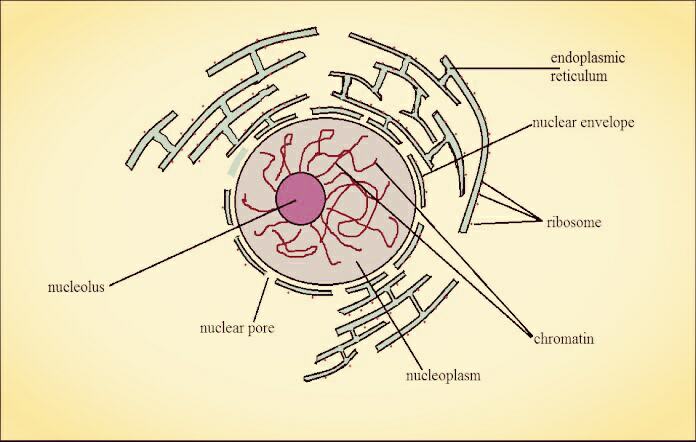
Answer
465.6k+ views
Hint: Nucleus is the defining feature of eukaryotic animals. It is the most vital part of a cell. It controls the functioning of the cell.
Complete answer:
A nucleus is defined as a double-membraned eukaryotic cell organelle that contains the genetic material in the form of chromosomes. It is the defining characteristic feature of eukaryotic cells. The credit for the discovery and naming of the nucleus goes to Robert Brown in 1833. Depending upon the number of the nucleus, a cell may be uninucleate, binucleate, or multinucleate. The shape of the nucleus may be discoid, ovoid, spherical, bilobed or multilobed. The outermost double-layered covering of the nucleus is called a nuclear membrane or karyotheca or nuclear envelope that is derived from phospholipids. The nuclear envelope is embedded by several small-sized pores known as nuclear pores. The nucleus is filled with nucleoplasm which contains chromatin i.e. thread-like structures of DNA. Within the nucleus, nucleolus is present which is a spherical body seen during interphase.
The functions of the nucleus are as follows:
1. It controls the heredity characteristics of an organism.
2. It maintains cellular metabolism by controlling the synthesis of particular enzymes.
3. It is responsible for the synthesis of RNA, protein synthesis, cell division, growth, and differentiation.
4. It stores hereditary material in the form of chromosomes which is made up of deoxyribonucleic acid (DNA) strands. It also stores proteins and ribonucleic acid (RNA).
5. It helps in the exchange of DNA and RNA (heredity materials) between the nucleus and the rest of the cell.
6. Nucleolus produces ribosomes and is known as protein factories.
Note:
1. Some cells such as sieve tubes of vascular plants and RBCs of mammals do not possess a nucleus though they originate from a eukaryotic organism.
2. The endoplasmic reticulum lies in close proximity to the nuclear envelope so that the internal compartment of the nuclear envelope is continuous with the lumen of the ER.
3. When a cell is “resting” i.e. not dividing, the chromosomes are organized into loose fibrous structures called chromatin and not into individual chromosomes.

Complete answer:
A nucleus is defined as a double-membraned eukaryotic cell organelle that contains the genetic material in the form of chromosomes. It is the defining characteristic feature of eukaryotic cells. The credit for the discovery and naming of the nucleus goes to Robert Brown in 1833. Depending upon the number of the nucleus, a cell may be uninucleate, binucleate, or multinucleate. The shape of the nucleus may be discoid, ovoid, spherical, bilobed or multilobed. The outermost double-layered covering of the nucleus is called a nuclear membrane or karyotheca or nuclear envelope that is derived from phospholipids. The nuclear envelope is embedded by several small-sized pores known as nuclear pores. The nucleus is filled with nucleoplasm which contains chromatin i.e. thread-like structures of DNA. Within the nucleus, nucleolus is present which is a spherical body seen during interphase.
The functions of the nucleus are as follows:
1. It controls the heredity characteristics of an organism.
2. It maintains cellular metabolism by controlling the synthesis of particular enzymes.
3. It is responsible for the synthesis of RNA, protein synthesis, cell division, growth, and differentiation.
4. It stores hereditary material in the form of chromosomes which is made up of deoxyribonucleic acid (DNA) strands. It also stores proteins and ribonucleic acid (RNA).
5. It helps in the exchange of DNA and RNA (heredity materials) between the nucleus and the rest of the cell.
6. Nucleolus produces ribosomes and is known as protein factories.
Note:
1. Some cells such as sieve tubes of vascular plants and RBCs of mammals do not possess a nucleus though they originate from a eukaryotic organism.
2. The endoplasmic reticulum lies in close proximity to the nuclear envelope so that the internal compartment of the nuclear envelope is continuous with the lumen of the ER.
3. When a cell is “resting” i.e. not dividing, the chromosomes are organized into loose fibrous structures called chromatin and not into individual chromosomes.

Recently Updated Pages
Who among the following was the religious guru of class 7 social science CBSE

what is the correct chronological order of the following class 10 social science CBSE

Which of the following was not the actual cause for class 10 social science CBSE

Which of the following statements is not correct A class 10 social science CBSE

Which of the following leaders was not present in the class 10 social science CBSE

Garampani Sanctuary is located at A Diphu Assam B Gangtok class 10 social science CBSE

Trending doubts
A rainbow has circular shape because A The earth is class 11 physics CBSE

Which are the Top 10 Largest Countries of the World?

Fill the blanks with the suitable prepositions 1 The class 9 english CBSE

How do you graph the function fx 4x class 9 maths CBSE

What is BLO What is the full form of BLO class 8 social science CBSE

The Equation xxx + 2 is Satisfied when x is Equal to Class 10 Maths

Give 10 examples for herbs , shrubs , climbers , creepers

Difference between Prokaryotic cell and Eukaryotic class 11 biology CBSE

Change the following sentences into negative and interrogative class 10 english CBSE




